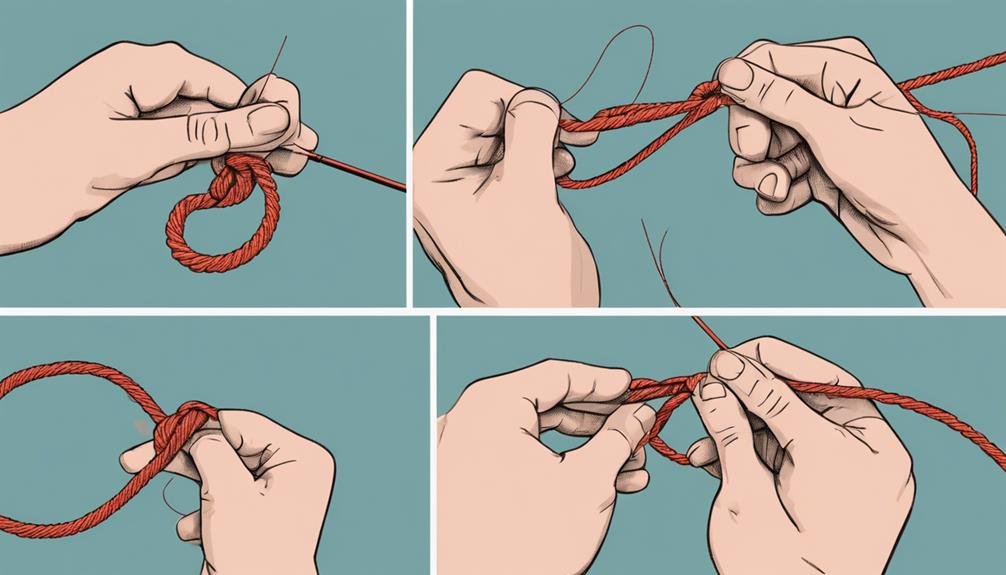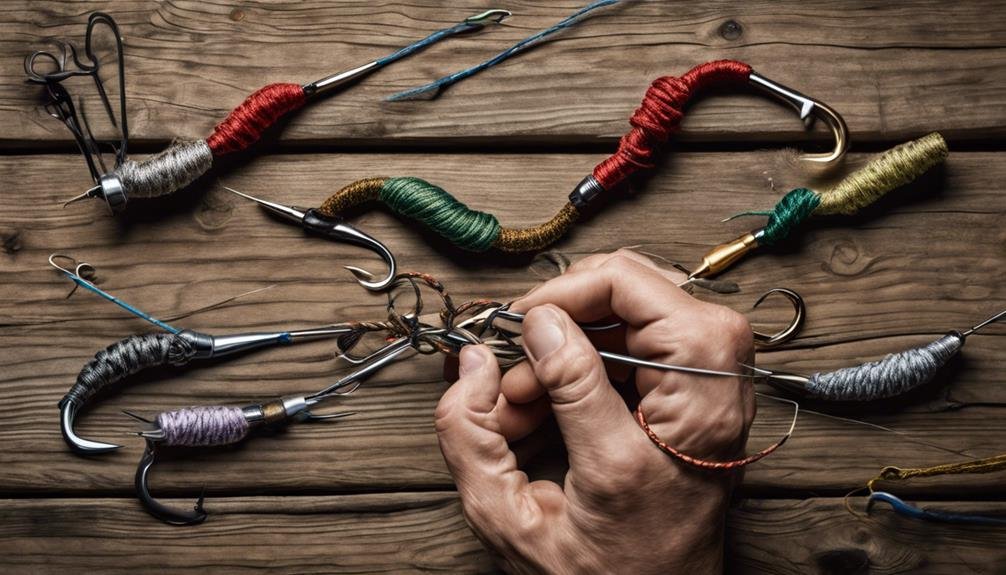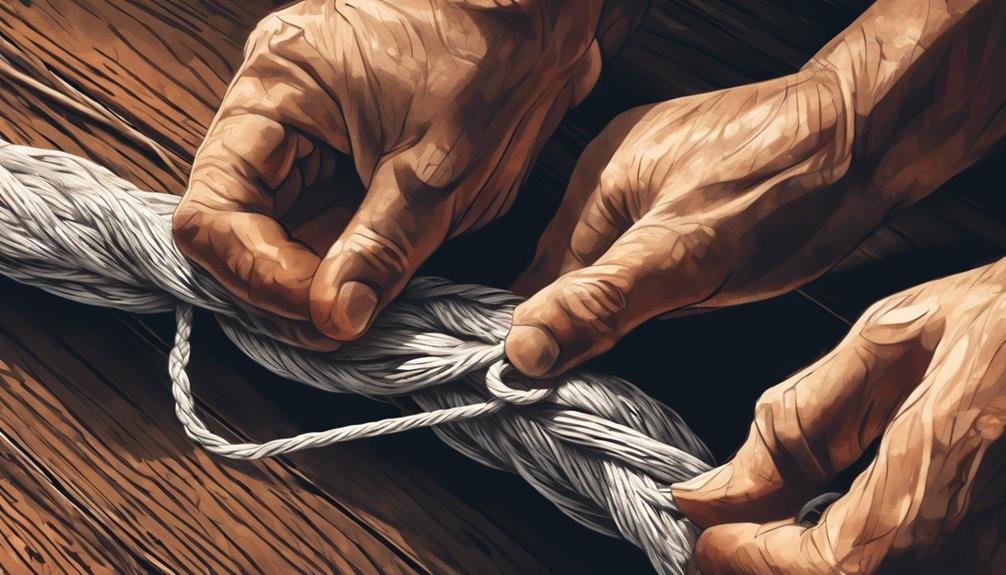When it comes to fishing, mastering the Snell Knot can greatly enhance your success rate, especially with live bait presentations. Have you ever wondered why so many bass anglers favor this specific knot favor this particular knot? The Snell Knot’s design guarantees a robust, dependable connection that keeps your hook aligned with the fishing line, but there’s more to it than just strength. Are you curious about the exact steps to tie this knot or the different hooks that work best? Let’s explore the nuances that make this knot an essential part of your fishing toolkit.
Key Takeaways
- The Snell Knot is a specialized fishing knot for attaching a leader or tippet to a baited hook.
- It involves passing the leader through the hook eye twice and wrapping it around the shank 7-8 times.
- The Uni Snell Knot variation enhances strength and reduces line slippage.
- A straight shank flipping hook with a Snell Knot is recommended for optimal performance.
- The Snell Knot is popular among bass anglers and effective for live bait and saltwater fishing.
What Is a Snell Knot

A Snell knot is a specialized fishing knot that attaches a leader or tippet to a baited hook. When you use a Snell knot, you’re ensuring a strong, reliable connection between your fishing line and hook. This knot involves passing the leader through the eye of the hook twice and then wrapping a loop around the hook shank multiple times. These steps align the fishing line perfectly with the hook shank, giving you a more secure and streamlined setup.
One of the main reasons anglers like you rely on the Snell knot is its effectiveness with thick-eyed hooks. It’s designed to maintain the line’s strength, giving you confidence that your tackle won’t fail when you need it the most.
The Snell knot is known for its reliability and is a go-to in various fishing scenarios, whether you’re fishing in freshwater or saltwater.
How to Tie a Snell Knot
Getting the hang of tying a Snell knot can make a big difference in your fishing game. This knot isn’t only straightforward but highly effective for securing your hook to the fishing line. To tie the Snell Knot, follow these steps:
First, pass your leader or tippet through the hook eye twice, ensuring the loops lie parallel to the hook shank. This initial step sets the foundation for a secure knot.
Next, create a loop by wrapping the leader around the hook shank 7-8 times. Be sure these wraps are tight and evenly spaced to maintain the knot’s integrity.
Once you’ve wrapped the leader around the shank, pass the tag end through the initial loop you created near the hook eye. Pull both the standing line and the tag end to tighten the knot. As you do so, the loops will cinch tight against the hook shank, firmly securing the knot.
The Snell Knot aligns the fishing line perfectly with the hook shank, preserving its strength and reliability. It’s especially useful for thick-eyed hooks, making it a favorite among anglers for its simplicity and effectiveness. Happy fishing!
Snell Knot Variations

Snell Knot variations can elevate your fishing technique, offering tailored solutions for different angling scenarios. One such variation is the Uni Snell Knot, favored by California pro-Bub Tosh. This knot is particularly useful when fishing in heavy cover, where reliability and strength are crucial.
Tying a snell using the Uni Snell Knot enhances the traditional Snell Knot for a more secure hook attachment. This knot is popular among anglers because it adds extra strength to your setup, making it especially effective for heavy fishing lines.
The Uni Snell Knot’s design reduces the chances of line slippage, so you can focus more on your catch and less on your gear failing.
The Uni Snell Knot not only offers a secure hook attachment but also provides superior hook-setting capabilities. This means that when a fish bites, your hook will likely stay in place, increasing your chances of a successful catch.
Best Hooks for Snell Knot
When using a snell knot, straight shank flipping hooks are your best bet for a secure connection. They’re especially effective for heavy-cover fishing, where precision and strength are essential. Manage your wraps and apply even pressure to avoid any weak spots in your knot.
Recommended Hook Types
Choosing the correct hook type is important when tying a snell knot, especially if you want to guarantee a strong and reliable connection. Straight shank flipping hooks are highly recommended for the uni snell knot. These hooks provide a consistent surface for the knot to grip, ensuring your line stays securely attached.
When using a straight shank hook, it’s vital to manage your wraps carefully. Ensure the wraps along the shank are even and don’t overlap, as this can compromise the knot’s integrity.
The tag end should be entered correctly through the eye of the hook. Incorrectly threading the tag end can lead to knot failure, which you want to avoid.
Another important step is evenly tightening the knot. An unevenly tightened knot can weaken under pressure and could ultimately cost you a catch. By focusing on these details, you’ll guarantee that your snell knot remains strong and reliable.
Optimal Use Cases
Building on the importance of choosing the right hook type, let’s explore the best use cases for the snell knot.
The uni snell knot is highly recommended When using a straight shank flipping hook. This combination is perfect for flipping and pitching heavy cover, where you need a strong, reliable connection. The snell knot allows the hook to align perfectly with your line, providing a direct and powerful hook set.
When tying the snell knot, avoid overlap in the wraps. Overlapping can weaken the knot, reducing its effectiveness. Carefully manage each wrap around the hook’s shank to guarantee they lay side by side. Enter the tag end correctly through the eye of the hook to secure a tight and durable knot. Tighten the knot evenly to maintain its integrity and strength.
The snell knot is also advantageous for hooks with a larger diameter shank, as it distributes the pressure evenly across the knot. This makes it less likely to slip or break under heavy load. Following these guidelines’ll optimize the snell knot’s potential, enhancing your fishing experience and making it more successful and enjoyable.
Advantages of Snell Knot

When you use the Snell Knot, you’ll benefit from its ability to maintain line strength, especially with thick-eyed hooks.
This knot guarantees your fishing line stays aligned with the hook shank, reducing slippage and maintaining a strong connection.
It’s suitable for various hooks, making it a versatile choice for many fishing scenarios.
Preserves Line Strength
The Snell knot stands out among fishing knots due to its remarkable ability to maintain line strength, making it a dependable choice for anglers. When you’re out on the water, the last thing you want is to worry about your line breaking under pressure. The Snell knot guarantees that the line strength remains intact, giving you confidence in your tackle.
Here are four reasons why the Snell knot is essential for maintaining line strength:
- Optimal Performance: The Snell knot aligns the line with the hook shank, minimizing stress points and securing the line so that it can perform at its best.
- Strength Under Pressure: Even when the fish fights, the Snell knot sustains line strength, reducing the risk of breakage.
- Thick-Eyed Hooks: The Snell knot is particularly suitable for thick-eyed hooks. It provides a secure and strong connection, perfect for various fishing situations.
- Proper Technique: With the right tying technique, you can secure the Snell knot and preserve line strength, making it a go-to for many anglers.
Suitable for Various Hooks
Whether you’re fishing in freshwater or saltwater, the Snell knot is a versatile and reliable choice for various hooks. This fishing knot is particularly suitable for thick-eye hooks, providing a secure connection that doesn’t compromise line strength. By aligning the fishing line with the hook shank, the Snell knot guarantees a more direct and firm attachment, essential for successful fishing.
Anglers appreciate the Snell knot for maintaining line strength, especially in heavy cover situations where durability is pivotal. This knot excels in reducing the chances of line slippage and offers superior hook setting, which is important for capturing your target. Popular in bass fishing, live bait presentations, and saltwater fishing, the Snell knot’s versatility shines through in various fishing scenarios.
Moreover, the Snell knot is highly favored for circle hooks, making it a top choice for many anglers. Its reliability and adaptability mean you’re less likely to lose your catch due to knot failure. Using the Snell knot, you can confidently tackle an array of fishing conditions and hook types, ensuring a more successful and enjoyable fishing experience.
Common Uses of Snell Knot
Due to its exceptional reliability and strength, the Snell knot is essential in various fishing scenarios. This knot excels at ensuring a secure connection between your line and hook, which is important for various types of fishing.
- Bass Fishing: The Snell knot is popular among bass anglers. Its ability to provide a secure hook attachment guarantees your bait stays in place, which is important when targeting bass.
- Live Bait Presentation: The Snell knot’s reliability shines when fishing with live bait. The knot keeps the bait in place, improving your chances of a successful catch. The tag is neatly tucked after forming the loop around the shank, preventing slipping.
- Saltwater Fishing: Saltwater anglers appreciate the Snell knot, especially with circle hooks. The knot’s design guarantees a better hook setting, which is necessary in the challenging saltwater environment.
- Catfish Catching: Known for their size and strength, catfish require a knot that won’t fail. The Snell knot offers superior hook-setting capabilities, making it a top choice for catfish anglers.
Alternative Fishing Knots

Exploring alternative fishing knots can significantly enhance your angling arsenal, providing tailored solutions for varied fishing conditions. While the Snell knot is reliable, understanding other fishing knots like the Riffle Hitch, Orvis Knot, Uni Knot, and Trilene Knot offers unique strengths and applications. These knots have distinct advantages, making them suitable for different scenarios and personal preferences.
The Riffle Hitch, for instance, is excellent for presenting flies in a natural drift.
The Orvis Knot provides a strong connection with minimal bulk, which is ideal for smaller hooks.
The Uni Knot is versatile and easy to tie, making it a favorite among many anglers.
Meanwhile, the Trilene Knot is known for its strength and reliability, especially with monofilament lines.
Practicing these various fishing knots boosts your versatility and increases your chances of success on the water. Each knot serves a specific purpose, so learning how to tie and when to use them is pivotal. Whether you need to tighten the knot on a different type of hook or adapt to fluctuating fishing conditions, mastering a range of knots will make you a more effective and confident angler.
Conclusion
To wrap up, mastering the Snell Knot can greatly enhance your fishing success. By ensuring a strong, reliable connection and perfect alignment with the hook shank, it’s a must-know for any angler. Whether you’re using live bait or tackling tough catches, the Snell Knot’s versatility can’t be overstated. So, next time you’re out on the water, don’t hesitate to tie a Snell Knot and experience its undeniable advantages firsthand.
FAQs
What is a Snell Knot, and why is it used?
A Snell Knot is a popular fishing knot that attaches a fishing line to a hook. It is particularly favored for securing hooks because it ensures the hook is aligned with the fishing line, providing a straight pull when setting the hook into a fish. This alignment increases the knot’s strength and reduces the chances of the hook pulling out. The Snell Knot is often used when a strong, reliable connection is crucial, such as with larger fish or heavy lines.
Key Benefits:
- Strong Connection: Ideal for securing hooks.
- Aligned Hook: Ensures a straight pull for better hook setting.
- Reliability: Reduces the risk of the hook pulling out.
How do you tie a Snell Knot?
Tying a Snell Knot involves a few straightforward steps:
- Thread the Line: Pass the end of the line through the hook eye, starting from the front of the hook, and pull about 6 inches of line through.
- Create a Loop: Form a loop by bringing the tag end of the line back along the hook shank.
- Wrap the Line: Hold the loop in place and wrap the tag end around the hook shank and the standing line 5-7 times.
- Tighten the Knot: Pull the tag end to tighten the wraps around the hook shank, then pull the standing line to secure the knot.
- Trim the Excess: Cut the excess tag end close to the knot.
Steps Recap:
- Thread the Line: Pass through the hook eye.
- Create a Loop: Form a loop along the shank.
- Wrap the Line: Wrap around the shank and line.
- Tighten: Secure the knot and trim the excess.
When is the Snell Knot most effective?
The Snell Knot is most effective when fishing with bait or circle hooks, as it ensures the hook remains in the optimal position for a solid hookset. It’s particularly useful for heavy lines and larger fish species where the strength of the connection is critical. Due to its reliability, the Snell Knot is also favored in saltwater and big-game fishing scenarios.
Best Use Cases:
- Bait Fishing: Keeps hooks aligned for better hooksets.
- Heavy Lines: Ideal for larger fish and stronger lines.
- Big-Game Fishing: Reliable in saltwater and challenging environments.

